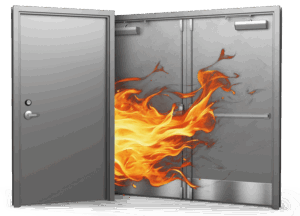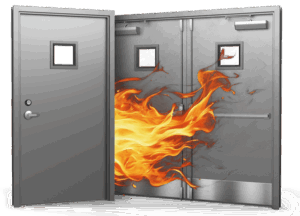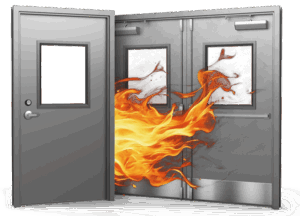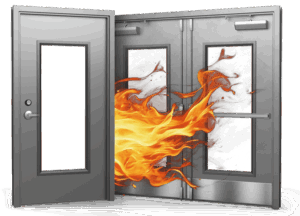What is the Fire Rating of a Commercial Metal Door?
The fire rating of a commercial metal door refers to the amount of time the door can withstand exposure to fire while maintaining its structural integrity and limiting the spread of flames and smoke. Most hollow metal doors are available with fire ratings ranging from 20 minutes to 3 hours, depending on their construction, core material, and the hardware used. A 3-hour fire-rated door is typically used in high-risk areas like boiler rooms, while 90-minute doors are common in stairwells and corridors. Fire-rated doors must be tested and certified by agencies such as UL or Intertek to meet building code requirements.

What are the most common fire ratings for commercial metal doors?
The most common fire ratings for commercial metal doors are 20 minutes, 45 minutes, 60 minutes, 90 minutes, and 180 minutes (3 hours). The required rating depends on the building code and the door’s location within the structure. For example:
- 20-45 minutes: Often used in corridors or room-to-room openings.
- 60-90 minutes: Common in stairwells, elevator shafts, or between occupancy types.
- 180 minutes (3 hours): Typically required for doors in high-risk areas like boiler rooms or walls separating buildings.
Each fire-rated metal door must be tested and certified by a recognized lab such as UL or Intertek to meet code requirements.


How is a fire rating determined?
Several components of a commercial metal door system determine its fire rating, including:
- Door Core: The core material is the primary factor. Fire-rated doors typically use mineral core, steel-stiffened core, honeycomb core, or other fire-resistant materials designed to withstand high temperatures.
- Door Frame: The frame must also be fire-rated and compatible with the door. It must be constructed to prevent the spread of flames and support the door under fire conditions.
- Hardware: Fire-rated doors require specific hardware, including fire-rated hinges, self-closing devices (door closers), fire-rated locks and latches, panic hardware or exit devices, if required by code.
- Glazing (if present): Any glass in a fire-rated door must also be fire-rated and meet or exceed the door’s rating. Wire glass or fire-resistive glazing is commonly used.
- Gasketing and Seals: Intumescent seals or smoke gaskets are often required to expand and seal gaps during a fire, especially in doors with smoke or temperature rise requirements.
- Label and Certification: The door assembly must be tested, certified, and labeled as a complete unit by an approved lab (like UL or Intertek). All parts must be listed and approved for use together.
Keep in mind, the fire rating is only valid when all components are installed correctly and part of a tested and certified assembly.
How are metal doors tested for their fire rating?
A fire rating is determined through standardized testing conducted by certified laboratories such as UL (Underwriters Laboratories) or Intertek (Warnock Hersey mark). In these tests, the door assembly is exposed to controlled fire conditions in a furnace to simulate real fire scenarios. The key steps include:
Fire Exposure Test: The door is subjected to intense heat for a specified period (e.g., 20, 45, 60, 90, or 180 minutes). The door must maintain its integrity, resist flame penetration, and limit temperature rise on the unexposed side.
Hose Stream Test (for ratings above 20 minutes): After the fire exposure, a high-pressure water hose is sprayed on the door to simulate the impact of fire hoses. This tests the door’s structural durability under stress.
Labeling and Certification: If the door passes, it receives a permanent label showing the fire rating and certifying agency. This label must remain visible to comply with building codes.
These ratings ensure the door can help contain fire and smoke, giving occupants more time to evacuate and protecting property.
Do all commercial metal doors come fire-rated?
Not all commercial metal doors come fire-rated. While many hollow metal doors are available with fire-rated options, they must be specifically manufactured, tested, and labeled to meet fire safety code requirements. A standard metal door without the proper certification cannot be assumed to provide any fire resistance.
To be considered fire-rated, a door must have a certified fire-resistant core (such as a mineral core or steel-stiffened core) designed to withstand high heat for a specified period. Additionally, the door must be part of a complete, tested assembly that includes a compatible fire-rated frame and approved hardware like closers, latches, and hinges.
A fire-rated door must also bear a permanent label from a recognized testing agency, such as UL (Underwriters Laboratories) or Intertek. This label indicates that the door has passed standardized fire tests and is approved for use in fire-rated applications. Importantly, the door must be installed according to the manufacturer’s instructions to maintain its rating.
Because building codes often require fire-rated doors in specific areas (like stairwells, corridors, or between occupancy types) it’s essential to verify that the door and all its components meet the required fire rating before installation.
Can a fire-rated metal door have glass?
Yes, a fire-rated metal door can have glass, but the glass must also be fire-rated and properly certified to meet safety codes. Not all types of glass are suitable for fire-rated doors, only specially manufactured fire-rated glazing can be used, and it must match or exceed the door’s fire rating.
Common fire-rated glass types include wired glass, ceramic glass, or intumescent laminated glass, which can withstand high temperatures for a specified period. The size and placement of the glass are also limited by fire codes and testing standards to ensure the door maintains its integrity during a fire.
Additionally, the glazing must be installed using approved fire-rated frames and glazing compounds. The entire assembly (door, glass, and framing) must be tested and certified together.
In summary, glass can be included in a fire-rated metal door, but it must be part of a tested and labeled fire-rated glazing system. Always verify with the door manufacturer and relevant building codes to ensure compliance.



Where are fire-rated metal doors typically required?
Fire-rated metal doors are typically required in areas of a building where containing fire and smoke is critical to occupant safety and property protection. Common locations include:
- Stairwells and Exit Enclosures: To maintain safe egress routes during a fire and prevent smoke or flames from entering escape paths.
- Corridors and Hallways: Especially in schools, hospitals, and commercial buildings, to compartmentalize sections of the building.
- Mechanical and Electrical Rooms: Where equipment poses a higher fire risk, such as boiler rooms or electrical closets.
- Elevator Shafts and Lobbies: To help prevent fire and smoke from traveling vertically through the building.
- Tenant Separations in Multi-Unit Buildings: Between residential or commercial units to reduce the spread of fire between spaces.
- Openings in Fire-Rated Walls: Anywhere a door interrupts a fire-rated wall, such as between a garage and interior space in mixed-use buildings.
These requirements are defined by local building and fire codes, which dictate the necessary fire rating based on the building’s use, size, and occupancy type. Fire-rated doors in these areas help ensure life safety and code compliance.
Do fire-rated doors require special hardware?
Fire-rated doors require special hardware that is specifically tested and approved for use in fire-rated assemblies. This hardware ensures the door closes properly and maintains its fire resistance during an emergency.
Key components include self-closing devices like door closers or spring hinges, which automatically close the door to contain fire and smoke. Locks and latches must be fire-rated to securely hold the door shut under heat. Fire-rated hinges, often heavy-duty steel or ball-bearing types, are necessary to withstand high temperatures. In emergency exits, panic hardware or exit devices provide safe egress while maintaining fire protection.
Additionally, many fire doors use intumescent seals or smoke gaskets that expand when heated to seal gaps and block smoke. All hardware must be listed and labeled for fire door use and installed according to manufacturer instructions to preserve the door’s certification and comply with building codes.
If you are in need of fire-rated commercial metal doors, take a look at them & get a quote here: Fire-Rated Metal Doors
If you have any additional questions about commercial metal doors, email us at [email protected] or give us a call at 800-685-7541 and we’ll be happy to help you out!





